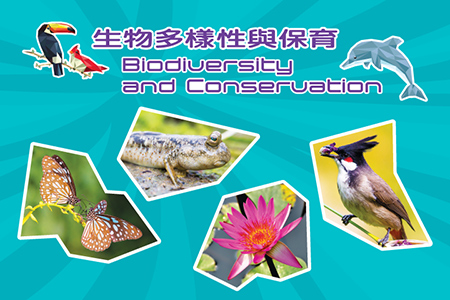Biodiversity and Conservation
|
With a land area of about 1,100 square kilometres and a population of over 7.2 million, Hong Kong is one of the most densely populated cities in the world. In fact, more than 60% of the land is woodland, shrubland, grassland or wetland. It also has a long coastline spanning over 1,000 kilometres, as it is surrounded on three sides by the sea. Such a unique geographical environment, together with a temperate subtropical climate, has created ideal habitats including forests, seashores and seagrass beds to many species. To protect these natural habitats, 24 country parks, 22 special areas (e.g. Tai Po Kau Nature Reserve and Hong Kong Wetland Park), several marine parks and marine reserve (e.g. Hoi Ha Wan Marine Park), and some conservation areas (e.g. Mai Po Nature Reserve) have been set up in Hong Kong, occupying over 500 square kilometres of the land and the sea. According to the statistics from the local government departments and green groups, more than 3,300 species of vascular plants, some 50 species of mammals, over 500 species of birds, 185 species of freshwater fish, over 100 species of amphibians and reptiles, more than 2,000 species of moths, about 235 species of butterflies and over 120 species of dragonflies are dwelling in Hong Kong with us. Some of them are rare species with great conservation value. For example, Hong Kong balsam, classified as endangered in China, is native to Hong Kong. Black-faced spoonbill, which is globally concerned, winters in Hong Kong every year. Romer’s tree frog is an indigenous species in Hong Kong. The Chinese white dolphin which inhabits Pearl River Estuary and Hong Kong waters is the largest population in China. Golden birdwing, a butterfly species of conservation concern, is widely distributed throughout Hong Kong. These diverse habitats and the abundant species of plants and animals have fully manifested the rich biodiversity of Hong Kong. Biodiversity is crucial to a healthy ecosystem, which provides resources for mankind, contributing to our well-being. Despite the great variety of living species in Hong Kong, local or even global biodiversity will be threatened, if issues such as environmental pollution, over hunting or poaching and global warming continue to deteriorate. China became a signatory to the Convention on Biological Diversity at the Earth Summit in 1992 and the convention was formally extended to Hong Kong through China in 2011. This is an international treaty with conservation of biological diversity as one of its major objectives. In response to the convention, the Government of the HKSAR is developing a Biodiversity Strategy and Action Plan, through arousing public awareness of ecological conservation and enhancing management of protected areas, to achieve sustainable use of biodiversity. We, as Hong Kong citizens and part of Mother Nature, have the responsibility to learn about biodiversity, protect ecological environment and contribute to conservation efforts. “Biodiversity and Conservation” is a themed topic for HK SciFest 2016. To deepen public understanding and appreciation of the flora and fauna in Hong Kong, the Hong Kong Science Museum has collaborated with various local organisations, including government departments, green groups and educational institutions, to organise a series of field visits, science camps, workshops and lectures during the HK SciFest to promote conservation. "Biodiversity and Conservation" themed programmes at a glance |

|








